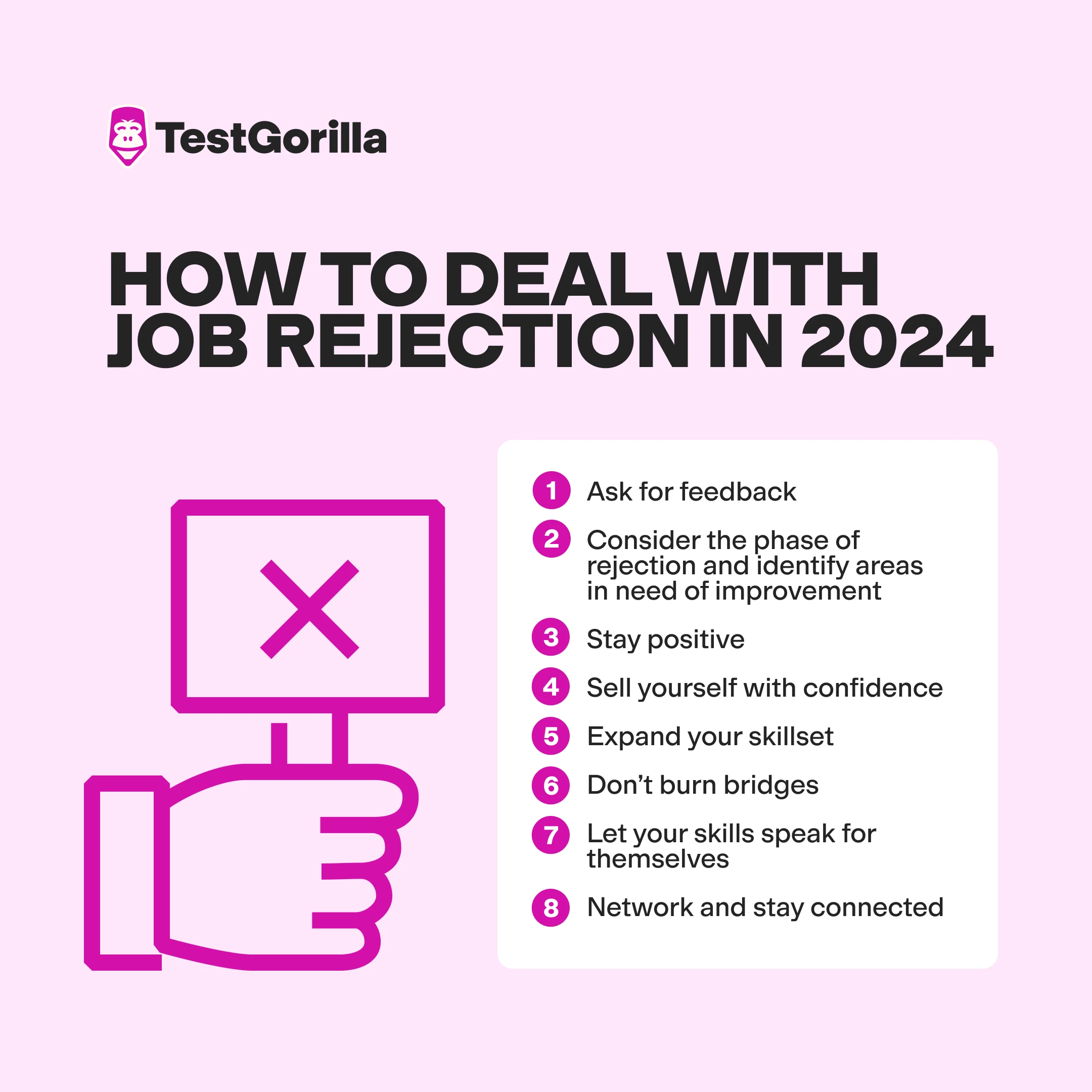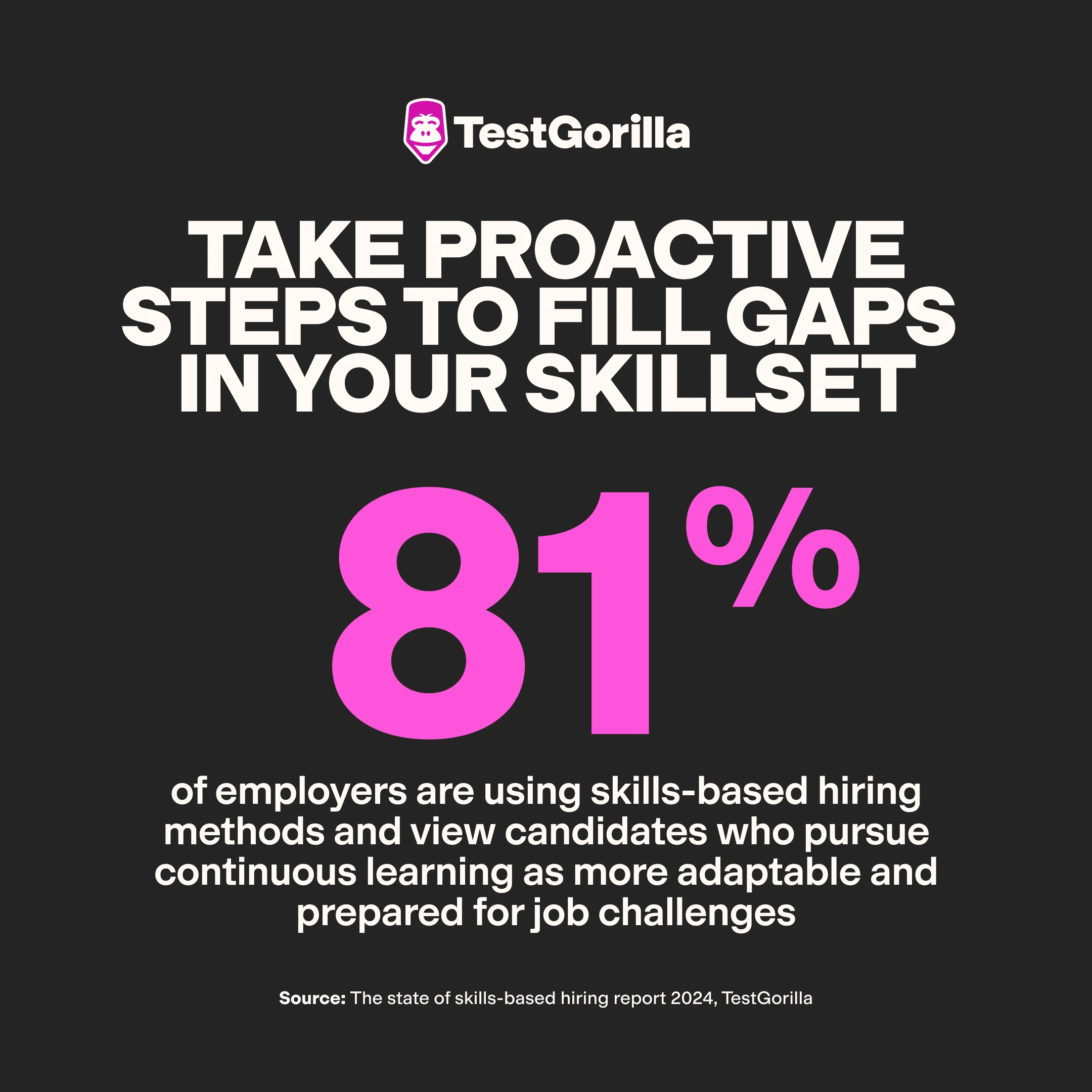You've just opened an email or answered a call, and there it is: "We've decided to move forward with another candidate."
The sting of rejection is real, and it can feel like you're back at square one. But the truth is, job rejection is a normal part of the journey – especially in 2024's competitive job market.
Whether you're a recent graduate, mid-career professional, or experienced worker seeking a career change, getting that rejection notice can feel like a personal blow. But it’s not the end of the story. In this guide, we'll explore practical ways to handle job rejection, learn from it, and move forward to get your dream job.
Key takeaways
Ask for feedback: Always ask for feedback after a rejection. It’s the best way to understand areas for improvement.
Consider the rejection stage: Reflect on whether you’re being filtered out at the resume, assessment, or interview stage, and adjust your approach accordingly.
Refine your skills: Take rejection as an opportunity to grow. Learn new skills, practice your interview technique, and always aim to improve.
Stay positive and professional: Your attitude matters. Don’t let rejection discourage you, and always leave a positive impression on potential employers.
Why are you getting rejected?
One of the toughest parts of job hunting is not knowing why you were passed over. Understanding the reasons behind rejection can help you adjust your approach and improve for future opportunities.
1. Ask for feedback
It may seem daunting, but asking for feedback is one of the best ways to understand where things went wrong. Did you lack a certain skill? Did other candidates have more experience? Understanding your weaknesses helps you improve and be better prepared for future opportunities.
To identify areas for growth, pay close attention to the specific skills or experiences mentioned in the feedback. For example, if an employer mentions you lack experience in project management, consider taking an online course to build that skill.
💡Quick resource: Here’s an email template you can use when asking for feedback!
Subject: Request for Feedback on My Recent Application
Dear [Hiring Manager's Name],
Thank you for considering me for the [Job Title] position. While I am, of course, disappointed that I wasn't selected, I truly appreciate the opportunity to interview with your team.
I would be grateful if you could provide me with any feedback on my application or interview. Understanding where I might improve would be incredibly helpful as I continue my job search.
Thank you again for your time and consideration. I hope to have the chance to work with [Company Name] in the future.
Best regards,
[Your Name]
2. Consider the phase of rejection
At what stage did you get rejected?
Initial application (ATS): If you're being filtered out at the resume stage, it could be because the applicant tracking system (ATS) isn’t picking up relevant keywords. Make sure your resume is tailored to the job description, using the right terms and phrases.
🌟Pro Tip: Consider tailoring your resume to match the job description by incorporating relevant keywords and phrasing. Use tools like resume optimization software or consult online resume guides to help improve your chances of passing the ATS round.
Assessment stage: If you made it past the initial application but didn't pass the skills assessment, it could mean you need to brush up on technical or theoretical skills. Consider it a prompt to revisit and strengthen those areas.
For example, if you’re applying for a role in the marketing industry, you might need to brush up on skills like data analysis or knowledge of digital marketing tools like Google Analytics. Strengthening these skills can help you perform better in future assessments and show employers you’re ready to take on the challenges of the role.
Interview stage: Did you make it to the interview but not get an offer? Reflect on how you presented yourself. Did you communicate your skills effectively? Did nerves get in the way? Interviews are a performance, and sometimes we just don’t pass the vibe check. That’s okay – it's something that can be improved with practice. To make a great impression in your interview, focus on clear communication, enthusiasm, and preparation.
Start by analyzing the feedback you receive – identify specific areas that need improvement, such as technical skills, interview performance, or how you present your experience. Set actionable goals to address these gaps, like enrolling in a relevant online course, practicing mock interviews, or refining your resume. Each rejection is a chance to become a stronger candidate, and the more you learn from each experience, the better prepared you'll be for the next opportunity.
How to improve for your next application
The following strategies will help you stay motivated, build your skills, and present yourself better in future applications.
3. Stay positive
Your attitude is key. It's easy to get discouraged, but staying positive will help you sell yourself confidently in future applications. Use rejection as motivation to strengthen your brand and refine your approach.
As author Suzy Kassem once said, "Fear kills more dreams than failure ever will." Take each rejection as a chance to improve not a reason to give up. To stay positive, remind yourself that rejection is a normal part of the job hunt, and focus on actionable steps like setting new goals, celebrating small wins, and keeping a gratitude journal to maintain a positive outlook.
4. Sell yourself with confidence
Rejections can make us second-guess our worth. But remember, it's not always about you – sometimes it's just about the company's needs at that moment. Focus on what you bring to the table and lead with that in your next interview.
How can you do this? Start by identifying your key strengths – whether it's a particular skill set, experience, or unique perspective – and find ways to articulate these clearly. Practice talking about your achievements in a way that highlights the value you can bring to a prospective employer.
Example: If you're applying for a project management position, instead of saying, "I have experience managing projects," you could say, "I successfully managed a team of 10 people to complete a high-stakes project ahead of schedule, which resulted in a 15% increase in client satisfaction." This way, you're not just stating your experience – you're demonstrating your impact.
5. Expand your skillset
According to TestGorilla's 2024 skills-based hiring report, 81% of employers are using skills-based hiring methods and view candidates who pursue continuous learning as more adaptable and prepared for job challenges. If feedback or reflection points to a gap in your skill set, take proactive steps to fill it. This could mean taking an online course, gaining a certification, or practicing a technical skill.
🌟Pro Tip! Platforms like Coursera and LinkedIn Learning are great tools to get more certs to add to your resume.
The best insights on HR and recruitment, delivered to your inbox.
Biweekly updates. No spam. Unsubscribe any time.
What to do after rejection
Here are some steps you can take to turn a rejection into an opportunity for growth and keep moving forward in your job search.
6. Don’t burn bridges
Respond professionally to a rejection email, especially after receiving feedback. Thank the employer for their time and consideration and express your interest in staying in touch.
Responding professionally shows employers that you are mature, emotionally intelligent, and genuinely interested in their company. Thanking them and expressing interest in future opportunities demonstrates resilience and keeps the door open for future roles – especially if you leave a lasting impression.
💡Quick resource: You can use this email template to tell an employer that you’d like to stay in touch!
Subject: Thank You for Your Feedback
Dear [Hiring Manager's Name],
Thank you so much for taking the time to provide feedback on my interview for the [Job Title] position. I truly appreciate your insights, and I will use them to improve my skills and approach in future opportunities.
I enjoyed learning more about [Company Name] and remain very interested in the possibility of working together down the line. Please feel free to keep me in mind for any future roles that might be a good fit.
Thank you again for your time and consideration.
Best regards, [Your Name]
7. Let your skills speak for themselves
Consider applying for jobs that use skills-based hiring, as these roles value your abilities over traditional resumes. Use job boards like TestGorilla to find these opportunities, and explore their resources to improve your skills and interview techniques. By focusing on skills-based roles, you ensure that your real abilities are what matter most.
💡Quick resource! We’ve curated many blogs for job seekers like yourself! Check out our articles like What are the 7 most common interview questions and answers? to sharpen your interview skills and more!
8. Network and stay connected
Tell recruiters or connections you made during the application process that you’re still interested in future opportunities. This can help you stay on their radar for upcoming roles.
Networking often leads to opportunities that aren't advertised publicly. It also helps spread the word about your skills and availability, as word of mouth remains a powerful way for employers to find candidates. In fact, studies revealed that 82% of companies use referrals and word of mouth to hire people because they get the best results that way.
🌟 Pro tip! Join LinkedIn groups or attend networking events to stay informed and connected with professionals.
Turn job rejection into growth with Test Gorilla
Whether you've faced your first rejection or many, remember that it's part of the journey. Use each experience to learn, grow, and improve your chances of success. Stay positive, refine your skills, and build connections to keep moving forward in your job search.
TestGorilla is here to guide you along your journey. Looking for your dream job? Start with our job board, where employers are encouraged to focus on skills-based hiring. Invited to take a TestGorilla assessment? Explore our assessment guides. Want to learn more about skills-based hiring? Take a look at our job seeker hub!
FAQs
How to get the job after being rejected?
Before reapplying, ask yourself why you want the job again and what has changed since your last application. Update your cover letter to reflect what you've learned and how you've grown. Prepare thoroughly for the interview to demonstrate your improvements and show the hiring team why you are an even stronger candidate.
Can you reverse a job rejection?
Reversing a job rejection is rare but possible. If you think there were misunderstandings or you've gained new qualifications, reach out to the employer and express your interest. Be polite, acknowledge their decision, and share any new skills or experiences. Showing enthusiasm and growth might make them reconsider if their situation has changed.
How many job rejections are normal?
It is normal to face several job rejections during the job search process. On average, job seekers might receive 5–10 rejections before landing a role. The exact number varies based on the industry, job market conditions, and your level of experience. Remember, persistence is key, and each rejection is an opportunity to learn and improve.
You've scrolled this far
Why not try TestGorilla for free, and see what happens when you put skills first.
















